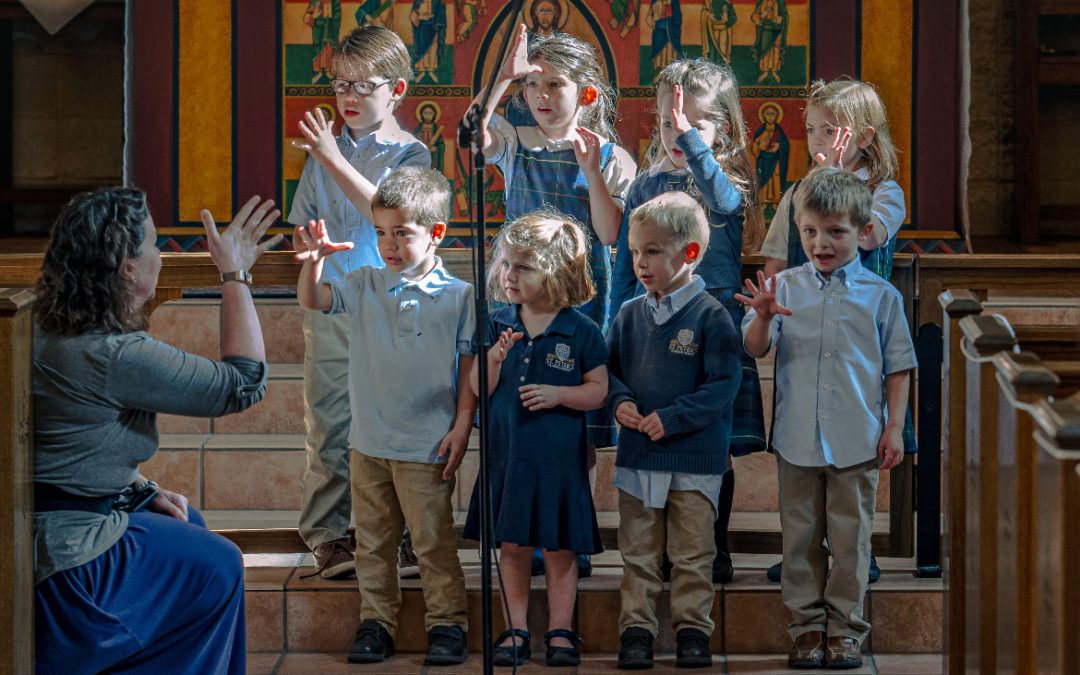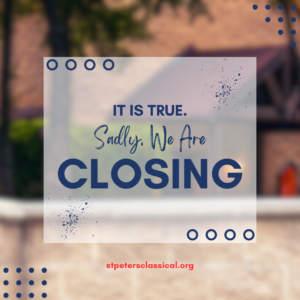Classical Preschool Program
As our name indicates, St. Peter’s Classical School utilizes the classical method of educating students. This includes our preschool program, and though our Kindergartners recite the entire scope of the Bible, our 4th graders spell better than most 8th graders, and our Juniors read classical texts in their original Latin or Greek, our student body is not composed of future Mensa candidates. How is this possible? We credit early childhood educators like Mrs. Midgley for starting our little ones out with a wonderful relationship to learning.
The preschool years are critical for laying a strong foundation for school readiness. But that doesn’t mean 4-year olds must be forced into a restrictive scholarly mould. Play is the important work of the preschooler. And Mrs. Midgley’s 20+ years of motherhood and teaching have only confirmed and deepened this belief. So, when prospective parents visit our preschool, they are amazed to discover just how effective our play-to-learn model can be.
Play-to-Learn
Class begins with a Morning Meeting. The children begin with good morning songs and calendar songs, and Mrs. Midgley often sneaks some math right in. For example, she might ask how many friends are here today and they work together to count the students. Then Mrs. Midgley asks how many teachers are in the class. Finally, she asks how many people are there altogether. Because some students only attend 3 days of the week, occasionally Mrs. Midgley poses the question, “How many friends would we have if everyone were here today?” After the songs, the class prays together using a little prayer they have learned. Lately, however, two of our little ones have started teaching their friends the Lord’s Prayer! The Morning Meeting wraps up by talking through the day’s schedule and the learning activities they will experience.
After the Morning Meeting, preschoolers are dismissed for some free play in the various centers set up around the room. During this free play, Mrs. Midgley calls one or two students at a time for their morning work activities which are centered on the class’ weekly phonogram (letter and sound). This morning work also includes activities that help children succeed in meeting the PreK objectives in fine motor skill development, language development, reading readiness, and math skills.
As you might expect, little ones have a lot of time to play. In addition to free play in the centers, there is outside play each morning and afternoon as well as P.E. twice a week. Specialist teachers also visit weekly for enrichment classes in Library, Bible, and Art. Perhaps the most powerful school readiness preparation that takes place circles around that morning work.
Reading Readiness
The entire lower school uses the Spell to Write and Read (SWR) curriculum for a robust language arts program. (This is why our 4th graders spell so spectacularly!) Mrs. Midgley skillfully connects the preschool program to the lower school program by introducing phonograms in the same order they are introduced in Kindergarten and beyond. All the learning activities for the week revolve around the weekly phonogram. For example, one of the favorite preschool phonograms every year is “P”. Students learn how pumpkins grow and count pumpkin seeds. They read If You Give a Pig a Pancake by Laura Numeroff and practice story sequencing as they talk back through the story. The class makes pizza for lunch and pancakes for snacks. Art projects and learning activities are filled with objects that start with “P”.
Each week is full of new phonogram adventures: cookies and caterpillars, elephants and eggs, Rudolph the Red-nosed Reindeer and robots. So, the cumulative effect is quite impressive. Three-quarters through the year, I brought a special Bible book to read with the class. (My main job is teaching Bible, Church History, and Theology across the whole school.) As I began to read, H is for Holy by Nika Boyd, the 4 year olds accurately identified each letter with its proper sound with every turn of the page. I was so impressed with their knowledge, and they were thrilled to discover new words that began with familiar phonograms!
Time Transitions
St. Peter’s is not content with only academic progress. As our mission states, we cultivate the intellect as we build the character and nurture the life of the spirit. And Mrs. Midgley brilliantly covers these categories of learning as well. In order to function well in school and the workplace, we all must learn to transition from one moment to the next. And we are rarely in control of when these transitions must happen. This skill is particularly challenging for little ones. So Mrs. Midgley uses a class bell. Students take turns ringing the bell and Mrs. Midgley happily instructs, “Show me five.” Students raise their hands high in the air with fingers outstretched as they receive a 5-minute warning of the coming change of activity. When it is time to clean up, she plays a “clean up song”, at the end of which the class space is neat and tidy again. Then another student moves a clothespin from the previous scheduled activity to the next. In this way, all students practice adjusting to the next part of their day.
It is so easy to admire the amazing work Mrs. Midgley accomplishes with each year’s bunch of preschoolers. Her heart is to instill a love of learning in our littlest students as she prepares them for the beginning of their academic journey. Students and parents love her. Other teachers appreciate the foundations she lays. And together we create a community that loves to learn together!
Need financial Aid?
Your first step is completing the admissions process.



0 Comments